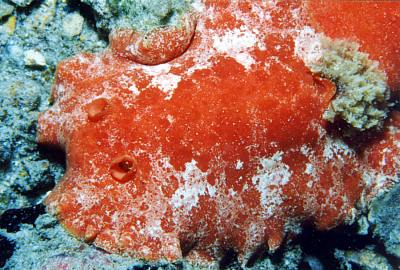
Platydoris angustipes
(Morch, 1863)
Order: NUDIBRANCHIA
Suborder: DORIDINA
Superfamily: EUDORIDOIDEA
Family: Dorididae
DISTRIBUTION
Caribbean
PHOTO
under the pier in Bonaire, Caribbean Sea, July, 1993. Photo: Linda Ianniello.
There is little information on the literature of the colour and shape of the living animal, the first being Marcus & Marcus (1967). The mantle ranges in colour from reddish brown, to red or orange. Thee are scattered white specks, especially on the mantle skirt, and there can be 3 or 4 larger white patches on each side. Right at the mantle edge there can be a thin translucent border which ranges in colour from straw to dark brown and can have scattered white triangular markings. The gills are translucent straw coloured with opaque white specks. Grows to approx 10cm long.
Reference:
• Marcus, Er. & Marcus, Ev. (1967) American opisthobranch mollusks. Part 1, Tropical American opisthobranchs. Studies Tropical Oceanography, Miami, 6(1-2): 1-137. (Figs 1-150, Pl.1, figs 1-9)
• Mörch, O.A.L. (1881). Contributions à la Faune malacologique des Antilles danoises. Journal de Conchiliologie, 11: 21-43
Rudman, W.B., 2001 (January 4) Platydoris angustipes (Morch, 1863). [In] Sea Slug Forum. Australian Museum, Sydney. Available from http://www.seaslugforum.net/find/platangu
Related messages
Platydoris angustipes from St. Vincent
March 22, 2007
From: Michael Pollack


Hi Bill,
I am currently tackling the task of identifying and categorizing my underwater images. I have found your website to be a tremendous (dare I say indispensible?) tool in conjunction with this project.
Locality: St. Vincent, Caribbean Sea, 10 August 2003. Length: 2 in.. Photographer: Michael Pollack.
I have attached a couple of photos of what I think is a Platydoris angustipes. I noticed that the Forum had relatively few images of this species and thought that you might want to include these.
Best regards,
Michael
www.untamedimages.com
michael@untamedimages.com
Pollack, M., 2007 (Mar 22) Platydoris angustipes from St. Vincent. [Message in] Sea Slug Forum. Australian Museum, Sydney. Available from http://www.seaslugforum.net/find/19702Thanks Michael,
Glad you like the Forum. A couple of good photos like these are always welcome. If you come across any animals 'doing things' during your great photo sort - that is feeding, mating, laying eggs etc - I am always interested. We know so little about the natural history of sea slugs, that any little clues are always valuable.
Best wishes,
Bill Rudman
Platydoris angustipes from Bonaire
January 16, 2006
From: Les Wilk

Hi Bill;
I notice that this forum doesn't have many images of Platydoris angustipes. Here's one from Bonaire.
Locality: west side, Bonaire, Caribbean. Depth: 25 feet. Length: 1.5 inches. July 2001. coral head. Photographer: Keri Wilk
Les Wilk
wilk@reefnet.ca
Wilk, L., 2006 (Jan 16) Platydoris angustipes from Bonaire. [Message in] Sea Slug Forum. Australian Museum, Sydney. Available from http://www.seaslugforum.net/find/15549
Thanks Les,
Always good to get a few additional photos. I have included a close-up alongside to show the complex - if subtle - colour pattern.
Best wishes,
Bill Rudman
Platydoris angustipes from Dominica
July 27, 2004
From: Linda Ianniello


Dr. Bill,
Enclosed are two shots of what I believe are Platydoris angustipes, two different pairs 'trailing'. I thought it would be interesting behaviour to add to the sightings of this species.
Location: Dominican Republic, Eastern Caribbean. Beach off Castle Comfort Hotel.
Depth: 15 to 20 feet
Size: approximately 1.5 inches
Date: July, 2004
One shot even shows slight color variations.
Regards,
Linda I.
lindai@us.ibm.com
Ianniello, L., 2004 (Jul 27) Platydoris angustipes from Dominica. [Message in] Sea Slug Forum. Australian Museum, Sydney. Available from http://www.seaslugforum.net/find/12703Thanks Linda,
Its nice to get some more information on this species. Trailing seems to be more widespread than we previously thought. Perhaps its just that we don't see many of these animals 'on the move'. We often find them sitting on or nestleed into their food colony.
Best wishes
Bill Rudman
Platydoris angustipes from Bonaire
September 25, 2002
From: Linda Ianniello


Dear Bill,
Attached is a photo of what I believe is Platydoris angustipes. It was found under the pier in Bonaire, Caribbean Sea, on a night dive, in July of 1993. (The famous Bonaire Town Pier, which really is a great night dive spot.)
Regards,
Linda I.
lindai@us.ibm.com
Ianniello, L., 2002 (Sep 25) Platydoris angustipes from Bonaire. [Message in] Sea Slug Forum. Australian Museum, Sydney. Available from http://www.seaslugforum.net/find/7983Dear Linda,
Thanks very much for a photo of this species. It is one of very few I have seen of this species as a living animal.
Best wishes,
Bill Rudman
Confirmation Platydoris angustipes
June 3, 2002
From: Alexander Taborda Marin


Dear Bill
Please help me in the confirmation of this nudibranch, thanks. I found it at Santa Marta, Caribbean coast of Colombia, at about 50 cm depth, on coral reef.
Alexander
alexandertaborda@hotmail.com
Marin, A. T., 2002 (Jun 3) Confirmation Platydoris angustipes. [Message in] Sea Slug Forum. Australian Museum, Sydney. Available from http://www.seaslugforum.net/find/7070Dear Alexander,
I am pretty sure this is Platydoris angustipes, but there is not a lot of published information on the external colour of this species. In species of Platydoris the mantle skirt is usually very thin, but tough and leathery. It is usually very stiff and only very slowly changes shape. The gill pocket is also raised and folded so that each gill has its own special fold.
Best wishes,
Bill Rudman
Picture of Platydoris angustipes
January 6, 2001
From: Jerel George
Can anyone direct me to a WWW picture of this critter? Thanks in advance,
Jerel George,
Islamorada,
Florida
landescaper@usol.com
George, J., 2001 (Jan 6) Picture of Platydoris angustipes. [Message in] Sea Slug Forum. Australian Museum, Sydney. Available from http://www.seaslugforum.net/find/3357Dear George,
I don't know of one off hand. Perhaps someone can send one to the Forum?
Best wishes,
Bill Rudman
